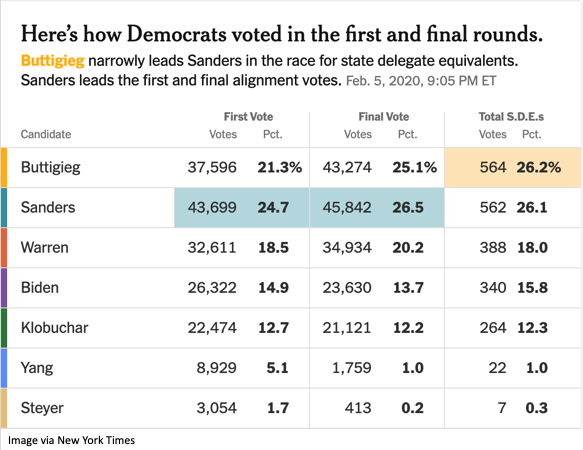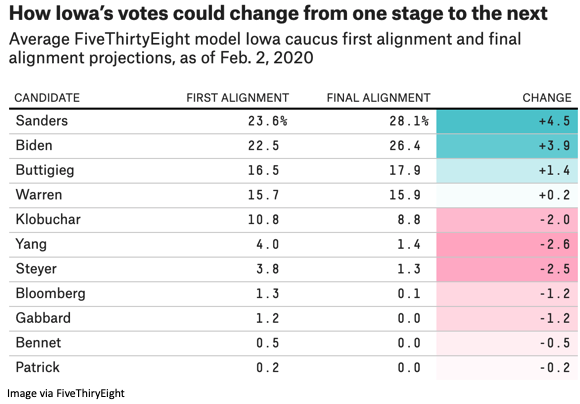The chaos of the recent Iowa Democratic caucuses took many political observers by surprise. Yet, in retrospect, the Iowa Democratic Party’s inability to report timely results is at least partly predictable. Leaving aside the technical problems attributed to the use of an app, it’s clear that changing how the state party reports its results played a role in the confusion on caucus night. In preparation for the 2020 primary, the Iowa Democratic Party (IDP) implemented a new set of rules as part of an effort to increase transparency. Results from the caucuses prior to this year had always been reported in terms of “state delegate equivalents,” or SDEs, but in 2020 the state party committed to releasing the results of all three stages of the caucus process.
Iowa’s 1,765 precincts are supposed to report (1) initial vote total or “first alignment,” (2) final vote total or “final alignment,” and (3) SDEs. Candidates must meet a 15 percent viability threshold in the first alignment in order to be counted in the final alignment total. This first alignment is the closest that Iowans come to having a “popular vote” metric in the process. Next, supporters of candidates that don’t meet the viability threshold can (a) join up with a viable group, (b) combine with other non-viable groups’ supporters to become viable, or (c) just go home. Once the realignment phase concludes, the final vote totals of all viable candidates are translated into the SDEs for each precinct.1 So how did the 2020 candidates in terms of these three measures of success?
With 100% of precincts reporting, the results show a close finish between Bernie Sanders and Pete Buttigieg. Sanders emerges as the winner of the first and final alignment results, receiving 24.7 percent in the first count and 26.5 percent in the final vote total. But in terms of winning the race for SDEs, the most up-to- date results indicate that Buttigieg appears to maintain an edge on Sanders, receiving 563.207 SDEs to Sanders’ 563.127, a razor-thin margin of .08 SDEs. This equates to 26.186 percent of SDEs for Buttigieg and 26.182 percent for Sanders. The rest of the Iowa field remained split between Warren, Biden, and Klobuchar.


In terms of winners and losers post-Iowa, Buttigieg clearly benefits from being perceived as the SDE winner, but the picture is complicated by Sanders’ dominant performance in the first and final alignments. Despite slightly undershooting expectations in final alignment numbers (-1.7 percent), Sanders can credibly claim victory by two out of three metrics in Iowa. Granted, 80 percent of media coverage by DNC debate poll sponsors tend to treat the SDE winner as the winner in Iowa, whereas only 20 percent of media outlets are covering the three metrics as equal. No matter who ends up winning Iowa, Sanders is in a good position headed into New Hampshire, where he maintains his lead in the polls by an average of 4-5 points in recent surveys.
However, Buttigieg’s strong performance in Iowa is a real surprise. In the days leading up to the caucuses, the FiveThirtyEight model predicted that Buttigieg would win 16.5 percent in the first vote and 17.9 percent in the final count. His final numbers outpaced expectations by nearly six points in the first measure and over seven points in the final alignment. Given the confusion surrounding the Iowa results, it seems unlikely that Buttigieg will get as much of a bump out of Iowa as his team might have hoped. Still, recent polling in New Hampshire suggests that Buttigieg has gained momentum at Biden’s expense. But it’s important to note that Buttigieg’s odds of winning a majority of pledged delegates has only risen to 5-6 percent and still polls at only 7 percent nationally.
A clear narrative forming out of Iowa is that Joe Biden underperformed relative to expectations. Compared to projections of the first and final votes, Biden undershot his expected numbers by more than seven points in the first count and nearly thirteen points in the final vote total. Since Iowa, Biden’s chances of winning a majority of pledged delegates have switched with those of Bernie Sanders, who now has a 44 percent chance to win the nomination, while Biden is down to a 20 percent chance. Despite this setback, Biden’s numbers nationally remain strong at 27 percent, even though he is expected to finish as low as fourth or fifth in the New Hampshire primary.
Turning to undercovered overperformers, both Warren and Klobuchar beat expectations in the caucuses. Warren overshot her projected first and final vote numbers by 2.8 points in the first vote and 4.3 points in the final alignment. On the other hand, Klobuchar outperformed her expected numbers by 1.9 points in the first vote and 3.4 points in the final vote. This means that the Warren and Klobuchar campaigns were more effective at consolidating support in the final vote than pre-caucus polls had accounted for. This has received less coverage in light of the post-Iowa Bernie-Biden-Buttigieg scrum.
What does this all mean for the Democratic primary going forward? Maybe not a lot! Iowa is traditionally supposed to winnow the field, but that largely hasn’t happened. Sanders’ chances of winning the nomination outright have increased, but so has the chance that no one will win a majority of pledged delegates (up to 25 percent, per the FiveThirtyEight model).
1 The practice of calculating SDEs from final alignment numbers is a notably archaic and convoluted process, distinctive of the Iowa caucuses. Historically, this involved electing delegates to county conventions, which then elected delegates to district conventions, the state convention, and eventually to the Democratic National Convention. Electing delegates in this way has been discontinued, but the weighting process for determining how precincts are counted as pledged delegates remains influential for how campaigns design their strategies. Since these weights are calculated based on how many votes Democratic candidates got in the last two general election cycles (2016 and 2018), the way that SDEs are constructed tends to give more weight to precincts in rural counties.

